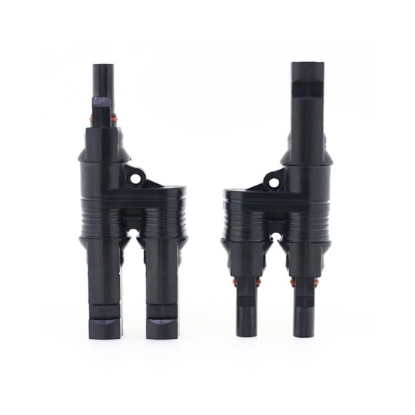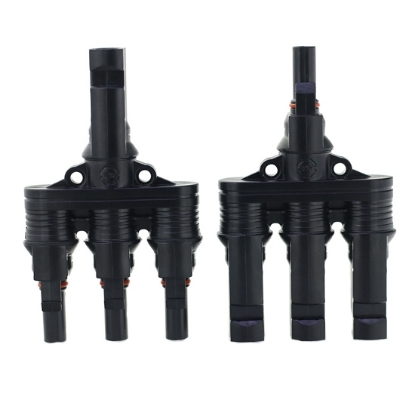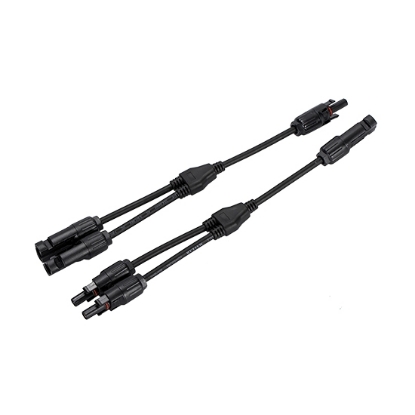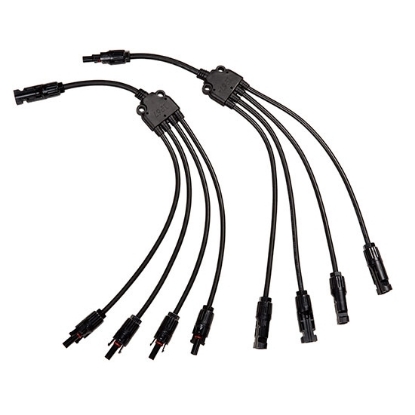-
You have no items in your shopping cart.
- Register
- Log in
- Wishlist
- Shopping cart
Solar Connector
Multi-Contact 4 Millimetre Solar Connector
Solar Module Connector, H Branch 2 to 1
Solar PV Panel Connector, H Branch 3 to 1
Solar Panle Connector, H Branch 5 to 1
Solar Panel Cable Connector, Y Branch 2 to 1
Solar Wire Connector, Y Branch 3 to 1
Solar Cable Connector, Y Branch 4 to 1
Solar Module Connector, H Branch 4 to 1
A solar connector is an important component used in solar power systems, and its main role is to connect solar panels with other electrical devices to ensure the efficient operation of the solar system. In solar power systems, solar module connectors are usually used to connect solar panels with inverters, batteries, and other equipment. Its design takes into account factors such as current transfer efficiency and impedance matching to ensure that the solar system can efficiently convert light energy into electricity and deliver it to the power network or energy storage devices. Solar connectors play a key role in solar power systems, ensuring stable operation and efficient power generation through reliable electrical connections.
Inverter shop can provide you with high-quality solar panel connectors to meet the needs for the perfect operation of your solar system. Inverter solar panel connectors are characterized by high precision and high reliability, which can ensure the stability and safety of the solar system, there are a variety of types of solar connectors to choose from, the Inverter store insists on quality first, is committed to Inverter store insists on quality first and is committed to providing customers with the best solutions to help you realize the efficient operation of solar photovoltaic systems.
Solar connectors are usually made of weather-resistant, waterproof, and dustproof materials to adapt to the harsh conditions of the outdoor environment. One of the main features of solar connectors is their waterproof performance. Since solar panels are usually installed outdoors, PV panel connectors must be waterproof to prevent rain, snow, or moisture from entering the interior of the solar connector, thus protecting the electrical equipment from damage. In addition, solar connectors also need to have high temperature, cold, and UV resistance to adapt to the operating environment under different climatic conditions.
Solar Connectors Working Principle
Electrical Connection: The plug and socket part of the PV module connector is electrically conductive, and the electrical connection is established through the contact point between the pins of the plug and the socket. The metal contact point formed between the plug and socket realizes the transmission of current and signal. The pins of plugs and sockets are usually pin or spring-shaped for reliable contact and electrical conductivity. When the plug is inserted into the socket, a tight connection is formed between the pins and the contact points, ensuring that current can be transferred from one component to another. PV module connectors are designed with low resistance, low contact resistance, and high conductivity in mind to minimize energy loss and ensure efficient transmission of electrical energy.
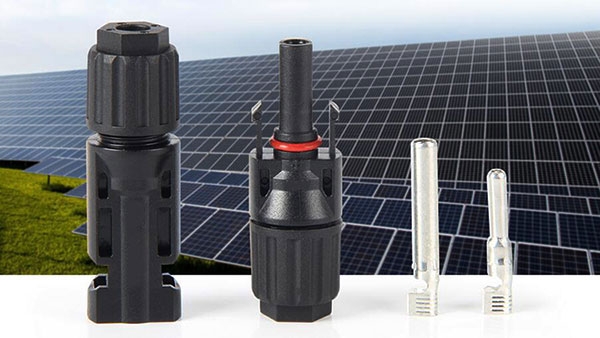
Mechanical Support: PV module connectors not only provide an electrical connection but also act as mechanical support. The shape and structure of the plug and socket parts are designed so that they can be firmly connected and resist the influence of the external environment. PV module connectors often utilize a locking mechanism or rotary locking system to ensure a strong connection between the plug and socket. This prevents the connector from loosening, falling off, or disconnecting accidentally, ensuring the stability and safety of the PV module. In addition, PV module connectors can withstand the effects of external environments such as mechanical stress, vibration, and temperature changes, maintaining a stable connection and reducing damage and disconnection due to external forces.
Functional Role of Solar Connectors
- Electrical Connection: Used to realize the circuit connection between solar panels or between panels and other components (e.g. inverter, string box), providing a reliable electrical connection to ensure the transmission and conversion of electrical energy.
- Mechanical Support: Provides not only electrical connection but also mechanical support to fix and support the PV modules to ensure that they are safely and securely mounted in the PV system against external environmental factors such as wind, rain, and vibration.
- Waterproof and Dustproof: The solar connectors are usually designed to be waterproof and dustproof, able to withstand moisture, rain, dust, etc. in outdoor environments. This ensures the reliability and durability of the solar panel connectors and reduces the risk of electrical failure.
- Compatibility and Interchangeability: Solar PV connectors are designed to meet specific standards and specifications to ensure that they are compatible with PV modules and other PV system equipment from different manufacturers. This allows for component interchangeability and flexibility, facilitating system maintenance and upgrades.
- Safety: Proper use and installation of light helps ensure the safety of the system. They are often equipped with safety features such as protection against electric shock, arcing, and fire to ensure operator and equipment safety. Overall, solar PV module connectors play a key connecting and supporting role in solar PV systems, not only realizing the connection of electrical circuits but also providing features such as water and dust resistance, mechanical support, and safety protection to ensure system reliability, performance, and safety.
How to Connect Solar Connectors?
Before any connection or operation, make sure the solar system is off. This includes disconnecting from the electrical network and disconnecting the solar panels from equipment such as inverters. Safety is always a top priority to avoid electric shocks or other accidents. Carefully check the quality of the solar panel connectors before connecting them. Make sure there are no visible damage, cracks, or waterproof sealing issues with the connectors. Good quality photovoltaic module connectors are essential for the long-term reliable operation of a solar system. Solar connectors typically have positive and negative polarity and it is important to ensure that the polarity is connected correctly. Generally, the anode is connected to the anode and the cathode is connected to the cathode to ensure that the current flows properly and to avoid problems such as backflow. Incorrect polarity connections can result in decreased system efficiency or equipment damage.
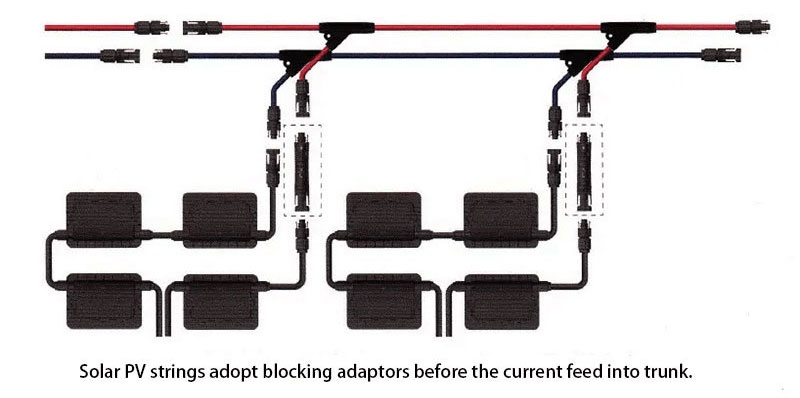
During the connection process, make sure the waterproof sealing of the solar connector is working properly. Use professional waterproof tape or glue to seal the connection part sufficiently to prevent rain or moisture from seeping in and protect the electrical equipment from damage. Once the solar module connector installation is complete, secure the solar connector in place to ensure that it is firm and reliable. This helps prevent the connector from being affected by external factors such as wind, rain, snow, etc., and maintains the stability of the system. Inspect the solar connector regularly to ensure it is working properly. Check the connectors for damage, corrosion, or other problems and perform timely maintenance. Regular inspection and maintenance help to improve the reliability and performance of the solar system.
Application Areas of Solar Connectors
- Photovoltaic Power Plants: Solar panel connectors play a key role in large-scale photovoltaic power plants. These plants often consist of hundreds or even thousands of solar panels, and solar connectors are used to connect these panels to battery packs to form a massive solar array. The efficient performance of the connectors ensures that the current is transferred quickly and steadily from the panels to the grid.
- Home Solar Power Systems: Solar module connectors are used to build solar panel systems in homes and small commercial applications. These systems can be installed on rooftops or other suitable sites, and the connectors deliver solar power to the home's electrical system or energy storage device, realizing self-sufficiency in green energy.
- Agricultural Use: PV panel connectors are also widely used in agriculture, for example to power irrigation systems. By connecting solar panels to water pumps or irrigation equipment, farmers can realize a self-sufficient water source and reduce their dependence on traditional electricity.
- Remote Area Power Supply: In remote areas or where there is no easy access to electricity, solar connectors can be used to set up standalone solar power systems to provide power to the local population. This application can effectively solve the problem of insufficient power supply and promote the utilization of renewable energy.
- Mobile solar Equipment: Solar panel connectors also play a key role in mobile solar equipment, such as solar chargers, campers, and boats on the solar power system. The design of the connector needs to take into account the portability of the device and the requirement to adapt to different environments.
The application of solar connectors in several fields has pushed the development of solar technology and provided a reliable foundation for the promotion and utilization of clean energy. As the demand for renewable energy grows, the application areas of solar connectors are expected to continue to expand.


